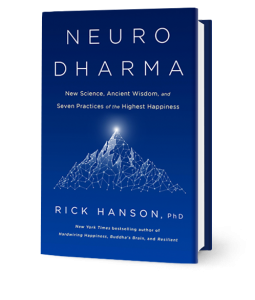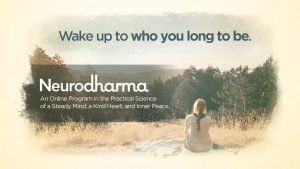
Neurodharma
Where would I find the science that forms your concept about the “Leading Edge of Now?”
From a third-person perspective, one can observe that there is a continuous “when something first happens” in any material process (which includes both matter and energy), such as the moment when the bat strikes a baseball, or the position of the ball in flight at any instant of time. One can also have a sense of the mathematics of calculus related to the instantaneous position and vector of the ball. And one can have some understanding of the complex neural processes underpinning any moment of consciousness. In other words, as processes occur, there is a (metaphorical) “front edge” to them, that instant when something first happens.
From a first-person perspective, one can be mindful of experiences as they appear and then change, and in their changing, how they end in some sense. Here, too, there is that instant when something first appears in consciousness. There are many studies of perception related to this. More generally, this aspect of phenomenology seems inherent and obvious, that there is an ongoing “appearing” in awareness of the next perception, thought, image, desire. So, putting the third and first-person perspectives together, it seems that both objectively and subjectively, there is a “front edge of now.” Perhaps the entirety of time has already been made and our perceptions simply “slide” along it. Nonetheless, at every moment in that sliding there is always the next thing that is encountered – as something that is happening or experienced – and that next thing is in effect the front edge of the sliding. Check out this book for some more on the physics.
How is your approach to “awakening” related to the Buddha’s 7 factors of awakening?
In Neurodharma, I approach steadiness, lovingness, fullness, wholeness, nowness, allness, and oneness as 7 aspects of awakening, 7 ways of being that are developed in awakening (thus in effect “steps” of awakening) and which when cultivated foster awakening.
In the last sense they are “factors” of awakening, but I tend to avoid that term in order to:
- avoid confusion with the Buddha’s “7 factors of awakening” (i.e., mindfulness, investigation, energy, bliss (rapture, joy), tranquility, concentration, equanimity) – which of course I respect profoundly
- emphasize the sense of being already what one aspires to be; the sense of dropping into a steadiness, nowness, etc. that is already true, already the case
What is this awareness really? What is the sole purpose of mindfulness?
My book Neurodharma speaks to much of what you raise. In a nutshell, what’s helpful is to establish a fairly stable mindful awareness of your inner and outer world, which simply means being present much of the time, with related qualities of acceptance of your experiences and supportiveness (e.g., self-compassion) toward yourself. This is a realistic goal. It’s OK to daydream and ruminate from time to time…just not all of the time!
Awareness is the field through which experiences pass. Over time, as practice deepens, there is a growing sense of being this space in which experiences occur, while holding all experiences more and more lightly, aware of their ephemeral nature. This will come naturally. And we can deliberately practice this sense of abiding aware, allowing experiences to come and go, in specific meditations.
Then there is the classic notion of a transpersonal “cosmic” consciousness that transcends the individual awareness of people…and cats and dogs and lizards and who knows spiders as well. Teachers and writers sometimes blur and therefore confuse the distinction between individual awareness – being aware of stimuli is a biological property of animals with a nervous system, which does not mean they are self-conscious like humans – and this possible transpersonal, transcendental awareness.
Clearly there is the natural process of awareness – aware-ing? – in you and me and cats and squirrels, and there may also be a transcendental awareness/consciousness. And perhaps these two shade into each other in the depths of our being.
Meanwhile, there is always the next step to take, whatever it is. That’s worth focusing on, for all of us. Other books you might like are Diana Winston’s The Little Book of Being and Jaimal Yogis’s Saltwater Buddha.
And of course, keep going!
What can be done about ``neural reductionism`` when that seems to be our default mode of operation?
I’m not sure what is meant by “neural reductionism” here, but if it includes the popular notion of “reducing consciousness to brain processes”, then I think there are different levels of analysis and different categories of causes that need to be explored. I don’t think the behavior of mice and hawks in a meadow “reduces” to the chemical processes in their bodies, let alone the quantum processes, but there is certainly a relationship between one and the other. Absent a resort to supernatural or transcendental factors, of course immaterial mental activity including consciousness – whether in humans, monkey, mice, or lizards . . . even spiders – must “reduce” to underlying material phenomena in the sense that the latter are necessary enabling and constructive conditions. But this does not mean that powerful ideas such as cultural helplessness or profound feelings such as love are “merely” electrochemical processes any more than the hunting behaviors of hawks are “merely” molecular processes. If you’re interested, check out some articles on Neurodharma in the Wise Brain Bulletin, which try to get at this; also my article The Mind, the Brain, and God.

Additional Resources
 Neurodharma by Rick Hanson, Ph.D.
Neurodharma by Rick Hanson, Ph.D.
The Self is a Unicorn excerpt from Dr. Rick Hanson’s book Neurodharma
Suffering and Happiness excerpt from Dr. Rick Hanson’s book Neurodharma


